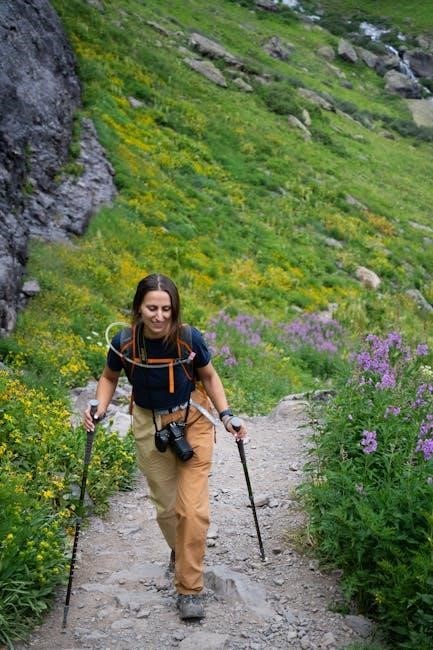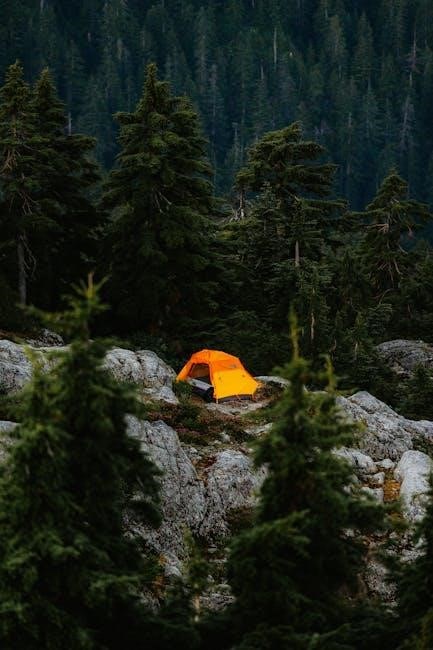Trail Camera Instructions: A Comprehensive Guide
Mastering trail camera setup involves proper orientation, using fresh batteries, formatting SD cards, and adjusting settings for optimal results. Patience and regular checks ensure success.
A trail camera, also known as a game camera, is a rugged, weather-resistant device designed to capture images or videos of wildlife in remote areas. These cameras are motion-activated, using sensors to detect movement and trigger captures. They are widely used by hunters, wildlife enthusiasts, and researchers to monitor animal activity, track patterns, and gather data. Trail cameras are equipped with features like night vision, timers, and memory storage, making them versatile tools for outdoor surveillance. Proper setup and configuration are essential to ensure clear images and reliable performance. Whether for hunting, security, or environmental monitoring, trail cameras provide valuable insights into the natural world, helping users understand and connect with wildlife effectively.
1.2 Importance of Trail Camera Setup
Proper trail camera setup is crucial for capturing high-quality images and ensuring reliable performance. Incorrect placement or configuration can lead to poor image quality, reduced detection range, or even camera damage. Facing the camera north or south minimizes glare, while positioning it at chest height optimizes animal detection. Ensuring batteries are fresh and memory cards are formatted prevents technical issues. Regular inspections and maintenance, like cleaning the lens and checking battery life, are essential for longevity. A well-configured camera provides clear, usable data, helping users monitor wildlife effectively and make informed decisions for hunting or conservation efforts. This foundation ensures the camera operates efficiently and delivers consistent results.

Camera Setup and Initial Configuration
Setting up your trail camera correctly ensures optimal performance. Insert fresh batteries, format the SD card, set date/time, and adjust basic settings. Proper positioning enhances functionality and image quality. Regular checks maintain reliability.
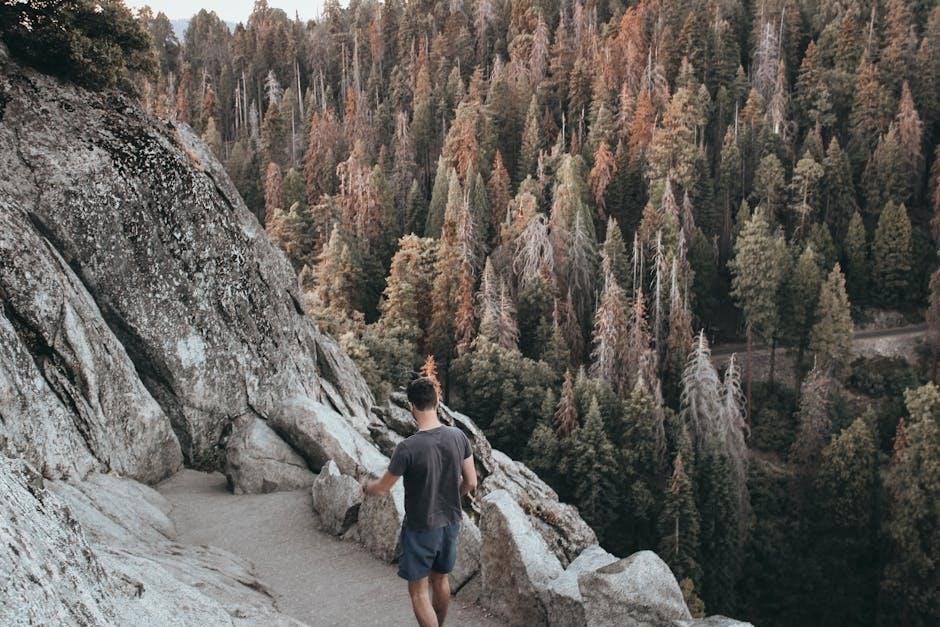
2.1 Inserting Batteries
Inserting batteries into your trail camera is the first step to ensure it operates properly. Open the battery compartment, usually located on the bottom or side, by unlatching the secure mechanism. Place the batteries in the tray, making sure to align the positive and negative terminals correctly. Gently press the batteries into their slots until they click into place. Close the compartment securely to avoid any moisture or dust entering. Always use fresh, high-quality batteries for optimal performance. If using rechargeable batteries, ensure they are fully charged before insertion. Properly installed batteries ensure your camera functions reliably in the field.
2.2 Inserting Memory Card
Inserting the memory card is crucial for storing images and videos. Locate the SD card slot, typically found near the battery compartment. Gently push the card into the slot until it clicks, ensuring the logo faces upward. If the card isn’t recognized, format it using the camera’s menu. Always use a high-quality SD card with sufficient storage capacity. Avoid using cards from other devices to prevent data corruption. After insertion, test the camera by taking a few photos to confirm proper functionality. Regularly format the card to maintain optimal performance and prevent errors. Securely close the compartment to protect the card from dust or moisture.
2.3 Setting Date, Time, and Camera Name
Accurately setting the date, time, and camera name is essential for organizing and identifying your footage. Navigate to the camera’s menu and select the date/time settings. Use the arrows to adjust the date, time, and time zone. Ensure the time is correct to avoid mismatches in your data. The camera name feature allows you to label each device, making it easier to track multiple cameras. Use a unique identifier, such as the camera’s location, to distinguish it from others. After configuring, save the settings to ensure they are stored properly. Correct timestamps and labels are critical for analyzing wildlife activity and managing your camera network effectively. Always double-check these settings before deploying the camera. Proper configuration ensures accurate and organized data collection.
2.4 Adjusting Basic Settings
Adjusting basic settings on your trail camera is crucial for optimal performance. Start with sensitivity settings, choosing high for more motion detection but risking false triggers. Set trigger speed to balance quick capture and battery life. For image quality, select medium resolution to avoid grainy photos and conserve memory. Enable video mode with suitable quality and duration to save storage. Set a time delay of 30 seconds to prevent rapid memory card fill-up. Adjust PIR sensitivity to reduce unnecessary captures from wind or small animals. Activate low-light settings for clearer nighttime images, mindful of battery consumption. Set recovery time moderately to avoid draining batteries. Ensure SD cards are formatted and sufficiently sized, starting with a 32GB card. Experiment with settings and monitor results to refine your configuration for best outcomes.
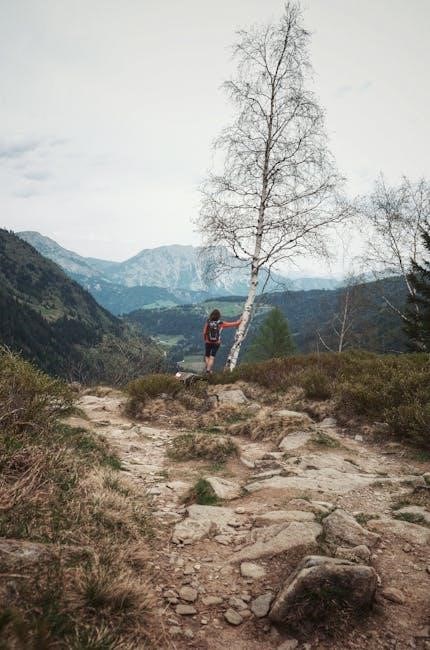
Positioning the Trail Camera
Mount the camera at chest height, facing north or south to avoid sun glare. Place it 15-20 feet from the target area for optimal detection and clear images.
3.1 Optimal Camera Orientation (North/South Facing)
Orienting your trail camera north or south minimizes glare and overexposure from direct sunlight, ensuring clearer daytime images. Avoid east-west placement to prevent sun interference during peak hours.
3.2 Ideal Height for Camera Placement
Placing your trail camera at chest height (approximately 3-4 feet) ensures optimal capturing of wildlife activity while minimizing detection by animals or thieves. Mounting too low may result in tampering or accidental triggers, while too high can reduce image quality. For security, consider elevating the camera to 15 feet or higher in a tree, though this may slightly compromise detection range. Ensure the camera is level and securely fastened to a sturdy tree or post to avoid movement or vibration. Test the placement with a few trial shots to confirm alignment and focus before leaving it unattended. Proper height balances functionality and security for reliable performance.
3.3 Aligning the Camera Angle
Properly aligning your trail camera’s angle is crucial for capturing clear and effective images. Position the camera to face north or south to avoid direct sunlight and glare, which can overexpose photos. Ensure the camera is level and parallel to the ground to cover the target area evenly; For game trails, aim the camera slightly downward to focus on the path where animals will pass. Adjust the angle based on the terrain and the height of the camera to ensure optimal coverage. Use test shots to verify the framing and make necessary adjustments. Aligning the camera correctly enhances image quality and ensures you capture the wildlife activity you’re monitoring. Proper alignment also helps minimize false triggers caused by moving vegetation or sunlight.
3.4 Maximizing Detection Range
To maximize your trail camera’s detection range, position it strategically based on the terrain and wildlife patterns. Aim the camera parallel to the ground to ensure even coverage and avoid tilting it upward, as this can reduce motion detection accuracy. For game trails, place the camera at a 45-degree angle to the path to capture approaching animals effectively. Ensure the camera is at least 15 feet high to deter theft and tampering, while still maintaining a clear view of the area. Use the camera’s motion sensor sensitivity settings to optimize detection without causing false triggers. Proper alignment and height adjustment ensure the camera captures wildlife activity efficiently, providing valuable insights into animal behavior and movement patterns in the area. Regular checks and adjustments help maintain optimal performance.

Camera Settings for Best Results
Optimize your trail camera by selecting modes like Photo, Video, Burst, or Timelapse based on your goals. Adjust sensitivity and timer settings for better image capture and reduced false triggers. Use Smart IR for clear nighttime images and ensure the detection range is set correctly. Regularly review and adjust settings to improve results. Proper configuration enhances image quality and ensures you capture the wildlife activity you’re monitoring. Tailor settings to specific locations and animal behaviors for optimal performance. Always test settings after changes to ensure functionality. This ensures you get the best footage possible, whether for hunting or wildlife observation. Adjustments may be needed seasonally to accommodate changing conditions and animal patterns. Keep settings consistent across multiple cameras for uniform results. Learning the camera’s features and how to apply them is key to successful wildlife monitoring. Experiment with different configurations to find what works best for your environment and objectives. Properly configured settings ensure reliable performance and high-quality images. By understanding and adjusting these settings, you can maximize your trail camera’s effectiveness and gather valuable insights into wildlife activity. Consistent monitoring and adjustments ensure the best results. Always refer to the user manual for specific setting recommendations. Adjusting settings based on location and season ensures optimal performance. Keep track of changes to refine your approach over time. This guide helps you make informed decisions to get the most out of your trail camera. By following these tips, you can achieve professional-grade results in wildlife photography and monitoring.
4.1 Using Photo Mode
Photo Mode is ideal for capturing high-quality images of wildlife. Set the camera facing north or south to avoid sun glare. Place it at chest height for optimal perspective. Use this mode for clear, detailed shots of animals. Ensure the camera is level and securely mounted. Photo Mode is best for monitoring specific areas like trails or feeding grounds. Adjust the trigger speed and sensitivity for fewer false triggers. Check the resolution and image quality settings to suit your needs. Regularly review photos to ensure proper framing and focus. This mode is perfect for identifying species, tracking behavior, and capturing crisp images. Avoid direct sunlight to prevent overexposure. Test the camera setup before leaving it unattended. Photo Mode provides reliable results for wildlife enthusiasts and hunters alike. Always ensure the camera is positioned to capture the desired field of view. Patience is key, as it may take time to capture the desired images. Regularly check and replace batteries to maintain functionality. Formatting the SD card periodically ensures optimal performance. Keep the lens clean to avoid blurry photos. Positioning the camera at the right height and angle is crucial for clear images. Avoiding obstructions in the camera’s view ensures unobstructed photos. This mode is essential for effective wildlife monitoring and surveillance. By following these tips, you can maximize the quality and utility of your trail camera photos. Proper setup and maintenance ensure consistent results. Adjust settings based on the environment and wildlife behavior for the best outcomes. Photo Mode remains a cornerstone of trail camera functionality, offering precise and reliable image capture. Always consider the lighting conditions and camera placement when using this mode. These adjustments will help you achieve the best possible results. Regular inspections and timely adjustments are vital for maintaining image quality. Photo Mode is a versatile and essential feature for any trail camera user. By mastering its use, you can effectively monitor and document wildlife activity. Always refer to the camera’s manual for specific settings recommendations. Experiment with different configurations to find what works best for your specific needs. Proper use of Photo Mode enhances your ability to capture high-quality images, making it an indispensable tool for wildlife enthusiasts and professionals alike. Consistent monitoring and adjustments ensure the best results. Always ensure the camera is positioned to capture the desired field of view. Patience is key, as it may take time to capture the desired images. Regularly check and replace batteries to maintain functionality. Formatting the SD card periodically ensures optimal performance. Keep the lens clean to avoid blurry photos. Positioning the camera at the right height and angle is crucial for clear images. Avoiding obstructions in the camera’s view ensures unobstructed photos. This mode is essential for effective wildlife monitoring and surveillance. By following these tips, you can maximize the quality and utility of your trail camera photos. Proper setup and maintenance ensure consistent results. Adjust settings based on the environment and wildlife behavior for the best outcomes. Photo Mode remains a cornerstone of trail camera functionality, offering precise and reliable image capture. Always consider the lighting conditions and camera placement when using this mode. These adjustments will help you achieve the best possible results. Regular inspections and timely adjustments are vital for maintaining image quality. Photo Mode is a versatile and essential feature for any trail camera user. By mastering its use, you can effectively monitor and document wildlife activity. Always refer to the camera’s manual for specific settings recommendations. Experiment with different configurations to find what works best for your specific needs. Proper use of Photo Mode enhances your ability to capture high-quality images, making it an indispensable tool for wildlife enthusiasts and professionals alike.
4.2 Video Mode Configuration
Video Mode allows you to capture extended wildlife behavior and movements. Set resolution and frame rate based on your needs. Enable features like Smart IR Video to reduce nighttime glare. Position the camera to avoid direct sunlight and glare. Use this mode for observing animal interactions and patterns. Ensure the memory card has enough storage for video files. Battery life may be shorter in Video Mode, so check and replace batteries regularly. Adjust sensitivity settings to minimize false triggers. Review footage to ensure proper framing and focus. Video Mode is ideal for detailed wildlife observation and security purposes. Regularly clean the lens to maintain video clarity. Position the camera at an optimal height and angle for clear recordings. Avoid obstructions in the camera’s field of view for uninterrupted video capture. This mode enhances your ability to study animal behavior and movements effectively. Always ensure the camera is securely mounted to prevent any movement during recording. Adjust settings based on the environment and wildlife activity for the best results. Video Mode provides valuable insights into wildlife habits, making it a powerful tool for enthusiasts and professionals alike. Proper setup and maintenance ensure high-quality video capture. Regular inspections and timely adjustments are crucial for optimal performance. By mastering Video Mode, you can gain a deeper understanding of wildlife behavior and patterns. Experiment with different configurations to find what works best for your specific needs. Video Mode is a versatile and essential feature for capturing detailed wildlife activity. Always refer to the camera’s manual for specific settings recommendations. Ensure the camera is positioned to capture the desired field of view. Patience is key, as it may take time to capture the desired footage. Regularly check and replace batteries to maintain functionality. Formatting the SD card periodically ensures optimal performance. Keep the lens clean to avoid blurry videos. Positioning the camera at the right height and angle is crucial for clear recordings. Avoiding obstructions in the camera’s view ensures unobstructed video capture. This mode is essential for effective wildlife monitoring and surveillance. By following these tips, you can maximize the quality and utility of your trail camera videos. Proper setup and maintenance ensure consistent results. Adjust settings based on the environment and wildlife behavior for the best outcomes. Video Mode remains a cornerstone of trail camera functionality, offering detailed and reliable video capture. Always consider the lighting conditions and camera placement when using this mode. These adjustments will help you achieve the best possible results. Regular inspections and timely adjustments are vital for maintaining video quality. Video Mode is a versatile and essential feature for any trail camera user. By mastering its use, you can effectively monitor and document wildlife activity. Always refer to the camera’s manual for specific settings recommendations. Experiment with different configurations to find what works best for your specific needs. Proper use of Video Mode enhances your ability to capture high-quality footage, making it an indispensable tool for wildlife enthusiasts and professionals alike.
Burst Mode is ideal for capturing rapid sequences of images when motion is detected. Set the burst mode to take 3-5 images per trigger to freeze fast-moving wildlife moments. Adjust the interval between bursts to conserve memory and battery life. This feature is especially useful for documenting fleet-footed animals like deer or birds. Ensure the SD card has enough storage capacity for multiple images. Position the camera in areas with high animal traffic for better results. Regularly review and delete unnecessary images to manage storage efficiently. Burst Mode enhances your ability to capture detailed wildlife interactions and behaviors. Proper setup and timely adjustments ensure optimal performance. This mode is a valuable tool for wildlife enthusiasts and researchers. Always check the camera’s settings to ensure it aligns with your monitoring goals. By using Burst Mode effectively, you can gain deeper insights into wildlife activity patterns. Regular maintenance of the camera ensures consistent results. Experiment with different burst settings to find what works best for your specific needs. Burst Mode is a powerful feature for capturing high-quality images of fast-moving subjects. Proper use and configuration are essential for maximizing its potential. Always refer to the camera’s manual for specific recommendations. This mode is a must-use for anyone looking to document wildlife behavior in detail. Regularly clean the lens and check the camera’s positioning to maintain image clarity. By mastering Burst Mode, you can capture stunning sequences of wildlife activity, providing valuable data for study or personal enjoyment. This feature is a cornerstone of trail camera functionality, offering a dynamic way to observe and record wildlife. Always ensure the camera is securely mounted to avoid any movement during bursts. Adjust settings based on the environment and wildlife behavior for the best outcomes. Burst Mode remains an essential tool for capturing multiple images quickly and efficiently. By following these tips, you can make the most of this feature and enhance your wildlife monitoring efforts. Proper setup and maintenance ensure consistent results, making Burst Mode a reliable choice for capturing high-quality images. Always consider the lighting conditions and camera placement when using this mode. These adjustments will help you achieve the best possible results. Regular inspections and timely adjustments are vital for maintaining image quality. Burst Mode is a versatile and essential feature for any trail camera user. By mastering its use, you can effectively document wildlife activity in detail. Always refer to the camera’s manual for specific settings recommendations; Experiment with different configurations to find what works best for your specific needs. Proper use of Burst Mode enhances your ability to capture high-quality images, making it an indispensable tool for wildlife enthusiasts and professionals alike. The Timelapse feature allows you to capture images at set intervals, providing a time-lapse sequence of events. This mode is ideal for monitoring long-term activity, such as seasonal wildlife patterns or habitat changes. Set the interval from minutes to hours, depending on your goals. Position the camera in an area with consistent animal traffic for best results. Timelapse is particularly useful for observing large areas or documenting gradual changes in the environment. Regularly review the footage to identify trends or specific events. Ensure the SD card has sufficient storage for extended recording periods. Adjust the camera angle and positioning to cover the desired field of view. Timelapse is a valuable tool for researchers and wildlife enthusiasts, offering insights into animal behavior and ecosystem dynamics. Proper setup and configuration are key to capturing high-quality, actionable data. Always check the camera’s battery life and storage capacity before enabling this feature. Timelapse mode complements other settings like photo and video modes, providing a comprehensive view of wildlife activity. Use this feature to track seasonal changes, monitor nesting sites, or study migration patterns. Regular maintenance ensures continuous and accurate data collection. Timelapse is an essential feature for capturing the bigger picture in wildlife monitoring. By leveraging this mode, you can gain deeper insights into long-term ecological processes. Always ensure the camera is securely positioned to avoid any movement during recording. Adjust settings based on the environment and wildlife behavior for optimal results. Timelapse mode is a powerful tool for documenting time-based changes, making it a must-use for wildlife enthusiasts and professionals alike. Proper configuration and regular checks ensure consistent performance. This feature enhances your ability to observe and analyze wildlife activity over extended periods. By mastering Timelapse mode, you can uncover valuable insights into the natural world. Always consider the lighting conditions and camera placement when using this mode. These adjustments will help you achieve the best possible results. Regular inspections and timely adjustments are vital for maintaining image quality. Timelapse mode is a versatile and essential feature for any trail camera user. By mastering its use, you can effectively document long-term wildlife activity and environmental changes. Always refer to the camera’s manual for specific settings recommendations. Experiment with different configurations to find what works best for your specific needs. Proper use of Timelapse mode enhances your ability to capture detailed, time-based data, making it an indispensable tool for wildlife enthusiasts and professionals alike. Regularly check and replace batteries, format SD cards, and clean the lens to ensure optimal performance. Perform inspections to address issues promptly and maintain functionality. Regular battery checks are crucial for trail camera functionality. Always use fresh batteries to prevent power issues. Open the battery compartment and ensure contacts are clean. Replace batteries every 6-12 months or when the low-battery indicator appears. Use high-quality, compatible batteries to maintain performance. If using rechargeable batteries, charge them fully before installation. Clean contact points with a soft cloth to avoid connectivity problems. Proper battery maintenance ensures uninterrupted operation and reliable image capture. Replace batteries during inspections or when performance declines. This step is vital for consistent camera operation and preventing data loss due to power failure. Formatting and managing SD cards are essential for optimal trail camera performance. Always format the SD card in the camera or via a computer to ensure compatibility. Regularly check the card’s capacity to avoid storage issues. Use high-quality, recommended SD cards to prevent data loss. Organize files by date or event for easy retrieval. Periodically check for errors using computer tools to maintain reliability. Format the card when performance issues arise or when using a new card. Handle the SD card carefully to prevent static damage. Label multiple cards for organization. This ensures consistent operation and reliable image storage. Cleaning the camera lens and body is crucial for maintaining image quality and functionality. Use a soft, dry microfiber cloth to gently wipe away dirt, dust, or moisture from the lens. Avoid harsh chemicals or abrasive materials that could scratch the surface. For stubborn smudges, dampen the cloth slightly with distilled water, but ensure it is not soaking wet. Regularly inspect the lens for debris and clean as needed. Also, clean the camera body to prevent dirt buildup, which could interfere with moving parts. Use compressed air to remove debris from crevices. Cleaning ensures clear images, prevents damage, and extends the camera’s lifespan. Consistent maintenance is key to reliable performance. Regular inspections are essential to ensure your trail camera operates effectively. Check the lens for clarity and clean it if necessary. Verify the battery levels and replace them if low. Inspect the SD card for proper formatting and sufficient storage space. Examine the camera’s mounting bracket and straps to ensure stability. Look for signs of wear or damage, such as loose screws or frayed straps. Test the camera by taking a few photos or videos to confirm functionality. Perform these checks before deploying the camera and after retrieving it. Regular inspections help prevent issues, ensuring you capture high-quality images consistently. Maintenance is key to reliable performance and accurate wildlife monitoring. Consistent checks save time and avoid missed opportunities. Always address any issues promptly to maintain optimal functionality. Ensure your camera is ready by checking batteries, formatting SD cards, and testing functionality. Mount securely at optimal height, and wait patiently for wildlife activity to capture quality images consistently. Check your trail camera after at least one week of deployment to allow wildlife to settle and avoid disturbing the area. Frequent checks can disrupt animal activity and reduce the likelihood of capturing quality images. If using Timelapse or motion sensors, wait for the scheduled period to elapse before retrieving footage. For security purposes, monitor remotely if possible. Always check during low-activity times, such as midday, to minimize disturbance. Regular inspections ensure functionality and prevent issues like drained batteries or full memory cards. Patience is key to maximizing the effectiveness of your trail camera setup and obtaining valuable insights into wildlife behavior or property surveillance. To protect your trail camera from theft or damage, use a sturdy lock and cable system to secure it to a tree or post. Mount the camera at least 15 feet high to deter thieves, as this makes it harder to reach. Position the camera in a discreet location, such as behind foliage, to reduce visibility. Regularly inspect the camera’s mounting system to ensure it remains stable and secure. Avoid placing the camera in low-lying areas prone to flooding or heavy animal traffic. By taking these precautions, you can safeguard your trail camera and ensure it continues to function effectively for wildlife monitoring or security purposes. Waiting for wildlife activity is a crucial part of using a trail camera effectively. Allow the camera to run undisturbed for at least one week before checking it, as frequent visits can scare animals away. Minimize human scent by avoiding direct contact with the camera and surrounding area. Keep activity around the camera to a minimum to ensure wildlife feels safe approaching. Be patient, as animal patterns may vary depending on food sources, weather, and seasonal changes. For best results, avoid checking the camera during peak wildlife activity times, such as dawn or dusk. Let the camera capture natural behavior without interference for optimal footage. When retrieving the memory card and footage from your trail camera, ensure you handle the process carefully to avoid damaging the card or losing data. Turn off the camera before removing the SD card to prevent corruption. Use a card reader to transfer files to your computer, and always back up your footage immediately. Check all images and videos to ensure they are clear and usable. Organize the files by date or location for easy reference. If using a viewer, avoid deleting or formatting the card in the field to prevent accidental loss of data. Regularly clean the memory card slot on the camera to maintain proper functionality and ensure smooth data retrieval.4.3 Burst Mode for Capturing Multiple Images
4.4 Timelapse and Timelapse Feature
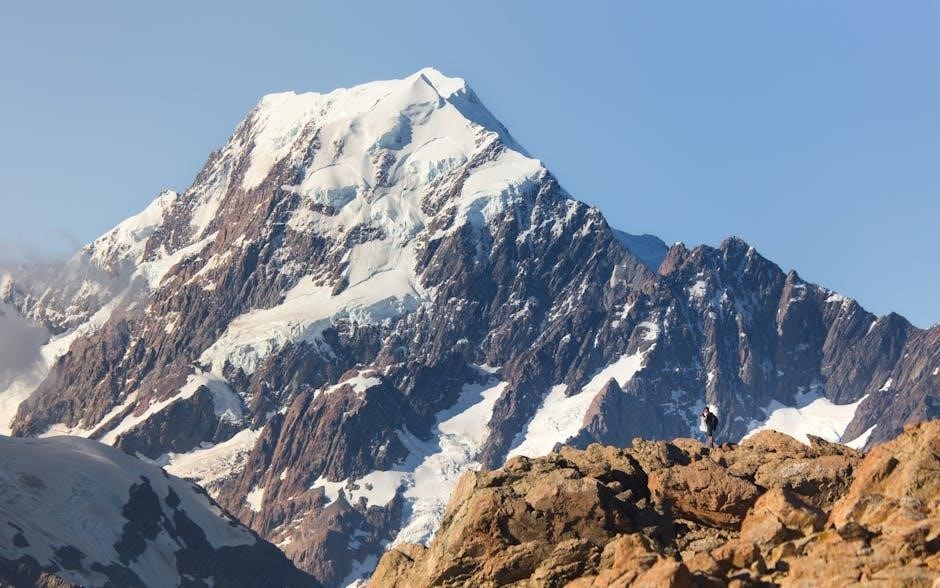
Maintenance and Troubleshooting
5.1 Checking and Replacing Batteries
5.2 Formatting and Managing SD Cards
5.3 Cleaning the Camera Lens and Body

5.4 Regular Inspections for Optimal Performance

Best Practices for Using Trail Cameras
6.1 When to Check the Camera
6.2 Securing the Camera from Theft or Damage

6.3 Waiting for Wildlife Activity
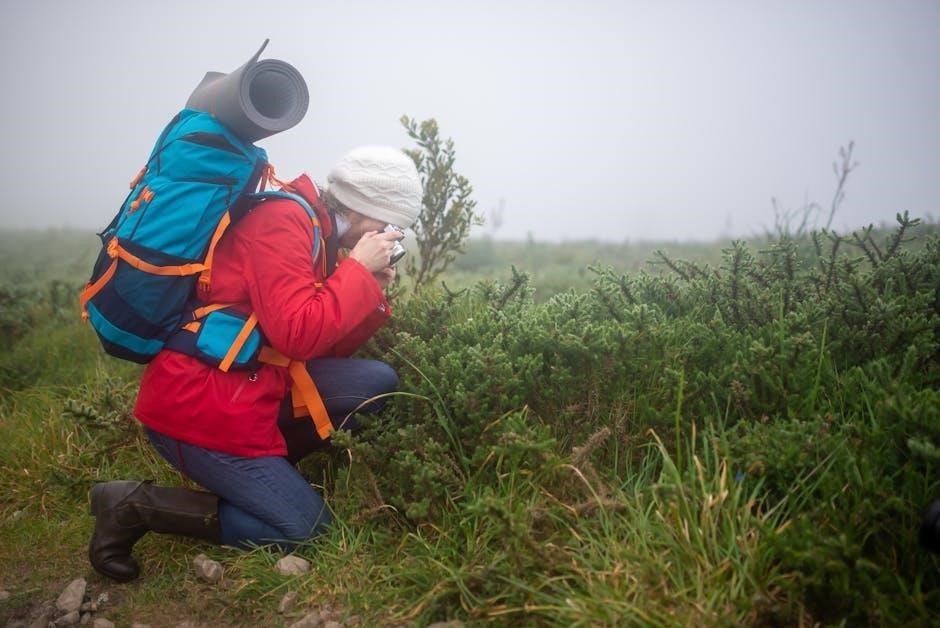
6.4 Retrieving Memory Card and Footage
